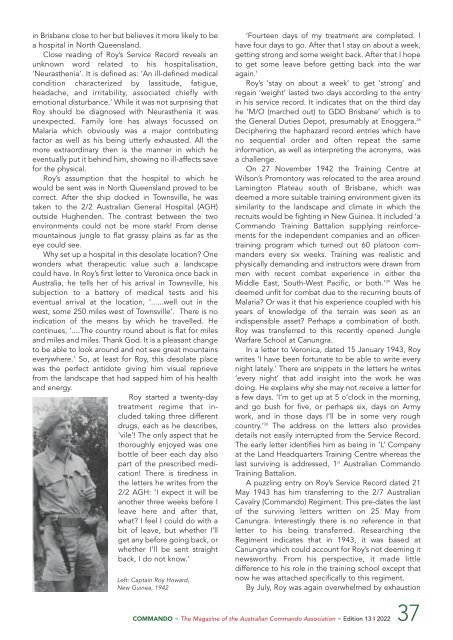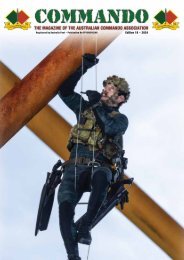Commando News Edition 13, 2022
Create successful ePaper yourself
Turn your PDF publications into a flip-book with our unique Google optimized e-Paper software.
in Brisbane close to her but believes it more likely to be<br />
a hospital in North Queensland.<br />
Close reading of Roy’s Service Record reveals an<br />
unknown word related to his hospitalisation,<br />
‘Neurasthenia’. It is defined as: ‘An ill-defined medical<br />
condition characterized by lassitude, fatigue,<br />
headache, and irritability, associated chiefly with<br />
emotional disturbance.’ While it was not surprising that<br />
Roy should be diagnosed with Neurasthenia it was<br />
unexpected. Family lore has always focussed on<br />
Malaria which obviously was a major contributing<br />
factor as well as his being utterly exhausted. All the<br />
more extraordinary then is the manner in which he<br />
eventually put it behind him, showing no ill-affects save<br />
for the physical.<br />
Roy’s assumption that the hospital to which he<br />
would be sent was in North Queensland proved to be<br />
correct. After the ship docked in Townsville, he was<br />
taken to the 2/2 Australian General Hospital (AGH)<br />
outside Hughenden. The contrast between the two<br />
environments could not be more stark! From dense<br />
mountainous jungle to flat grassy plains as far as the<br />
eye could see.<br />
Why set up a hospital in this desolate location? One<br />
wonders what therapeutic value such a landscape<br />
could have. In Roy’s first letter to Veronica once back in<br />
Australia, he tells her of his arrival in Townsville, his<br />
subjection to a battery of medical tests and his<br />
eventual arrival at the location, ‘......well out in the<br />
west, some 250 miles west of Townsville’. There is no<br />
indication of the means by which he travelled. He<br />
continues, ‘....The country round about is flat for miles<br />
and miles and miles. Thank God. It is a pleasant change<br />
to be able to look around and not see great mountains<br />
everywhere.’ So, at least for Roy, this desolate place<br />
was the perfect antidote giving him visual reprieve<br />
from the landscape that had sapped him of his health<br />
and energy.<br />
Roy started a twenty-day<br />
treatment regime that in -<br />
cluded taking three different<br />
drugs, each as he describes,<br />
‘vile’! The only aspect that he<br />
thoroughly enjoyed was one<br />
bottle of beer each day also<br />
part of the prescribed medi -<br />
ca tion! There is tired ness in<br />
the letters he writes from the<br />
2/2 AGH: ‘I expect it will be<br />
another three weeks before I<br />
leave here and after that,<br />
what? I feel I could do with a<br />
bit of leave, but whether I’ll<br />
get any before going back, or<br />
whether I’ll be sent straight<br />
back, I do not know.’<br />
Left: Captain Roy Howard,<br />
New Guinea, 1942<br />
‘Fourteen days of my treatment are completed. I<br />
have four days to go. After that I stay on about a week,<br />
getting strong and some weight back. After that I hope<br />
to get some leave before getting back into the war<br />
again.’<br />
Roy’s ‘stay on about a week’ to get ‘strong’ and<br />
regain ‘weight’ lasted two days according to the entry<br />
in his service record. It indicates that on the third day<br />
he ‘M/O (marched out) to GDD Brisbane’ which is to<br />
the General Duties Depot, presumably at Enoggera. 28<br />
Deciphering the haphazard record entries which have<br />
no sequential order and often repeat the same<br />
information, as well as interpreting the acronyms, was<br />
a challenge.<br />
On 27 November 1942 the Training Centre at<br />
Wilson’s Promontory was relocated to the area around<br />
Lamington Plateau south of Brisbane, which was<br />
deemed a more suitable training environment given its<br />
similarity to the landscape and climate in which the<br />
recruits would be fighting in New Guinea. It included ‘a<br />
<strong>Commando</strong> Training Battalion supplying reinforce -<br />
ments for the independent companies and an officertraining<br />
program which turned out 60 platoon com -<br />
manders every six weeks. Training was realistic and<br />
physically demanding and instructors were drawn from<br />
men with recent combat experience in either the<br />
Middle East, South-West Pacific, or both.’ 29 Was he<br />
deemed unfit for combat due to the recurring bouts of<br />
Malaria? Or was it that his experience coupled with his<br />
years of knowledge of the terrain was seen as an<br />
indispensible asset? Perhaps a combination of both.<br />
Roy was transferred to this recently opened Jungle<br />
Warfare School at Canungra.<br />
In a letter to Veronica, dated 15 January 1943, Roy<br />
writes ‘I have been fortunate to be able to write every<br />
night lately.’ There are snippets in the letters he writes<br />
‘every night’ that add insight into the work he was<br />
doing. He explains why she may not receive a letter for<br />
a few days. ‘I’m to get up at 5 o’clock in the morning,<br />
and go bush for five, or perhaps six, days on Army<br />
work, and in those days I’ll be in some very rough<br />
country.’ 30 The address on the letters also provides<br />
details not easily interrupted from the Service Record.<br />
The early letter identifies him as being in ‘L’ Company<br />
at the Land Headquarters Training Centre whereas the<br />
last surviving is addressed, 1 st Australian <strong>Commando</strong><br />
Training Battalion.<br />
A puzzling entry on Roy’s Service Record dated 21<br />
May 1943 has him transferring to the 2/7 Australian<br />
Cavalry (<strong>Commando</strong>) Regiment. This pre-dates the last<br />
of the surviving letters written on 25 May from<br />
Canungra. Interestingly there is no reference in that<br />
letter to his being transferred. Researching the<br />
Regiment indicates that in 1943, it was based at<br />
Canungra which could account for Roy’s not deeming it<br />
newsworthy. From his perspective, it made little<br />
difference to his role in the training school except that<br />
now he was attached specifically to this regiment.<br />
By July, Roy was again overwhelmed by exhaustion<br />
COMMANDO ~ The Magazine of the Australian <strong>Commando</strong> Association ~ <strong>Edition</strong> <strong>13</strong> I <strong>2022</strong> 37
















